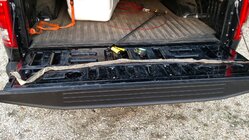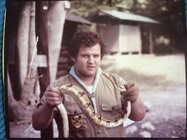- Joined
- Apr 27, 2004
- Messages
- 9,232
- Likes
- 5,889
- Location
- Lakeland, Florida
- Website
- www.hockenberywoodturning.com
Just saw an extensive Nat Geo article on Osage Orange. By Douglas Main
If you subscribe : https://www.nationalgeographic.com/...-of-evolution?loggedin=true&rnd=1721842445355
“Before the last Ice Age, the Osage orange had a vast distribution, from Florida north to Ontario. But then, starting around 125,000 years ago, glaciers advanced south to cover much of North America. Once the glaciers retreated around 12,000 years ago, the Osage orange did not quickly re-expand to the north like many other tree species—and in fact may have continued to shrink in range.”
“Before Europeans arrived, large populations of the tree were mostly restricted to portions of Arkansas, Oklahoma, and Texas, and possibly small parts of Kansas, Louisiana, and Missouri. Pre-settlement trees have also been found in Kentucky, Tennessee, and Virginia, says Tom Kimmerer, an independent forest scientist, consultant, and author based in Lexington, Kentucky.”
“ Native Americans may have helped spread the tree and might have traded in its fruits or cuttings in addition to its wood, Kimmerer says.”
“ Regardless, European settlers took notice of the plant. Early French explorers called it bois d'arc—French for “bow-wood”—which eventually became bodark. In 1804, at the beginning of his famous journey with William Clark, Meriwether Lewis obtained cuttings of Osage orange in St. Louis and sent them to President Thomas Jefferson for propagation.”
“ The first “hedge mania” began around 1850. At that time, fencing was expensive and difficult to maintain. Feral hogs were an even worse plague then, compared to today. But Osage orange hedges—said to be “horse high, hog tight, and bull strong,” as the saying went—offered a solution. Jonathan Turner, a professor who promoted use of the plant in Illinois and beyond, was convinced that “God designed Osage Orange especially for the purpose of fencing the prairies.” He also helped established the University of Illinois, based in in Champaign—where I was raised and first met the fruits of Turner’s enthusiasm.”
“ By 1869, around 60,000 miles of Osage orange hedges had been planted in the Midwest and South. Some consider Osage orange to be as important as the railroad, steel plow, and windmill for the settlement of the Midwest by Europeans, according to Michael Ferro,”
“ Take its wood, for example: It burns hotter than any other in North America, resists decay better than any other in the world, and is both flexible and incredibly strong. This rare combination makes it the world’s best wood for archery bows.”
If you subscribe : https://www.nationalgeographic.com/...-of-evolution?loggedin=true&rnd=1721842445355
Here's the original native range of Osage orange.
Kent, yes, that’s its original “native” range, but look where it is found now :
View attachment 65181
“Before the last Ice Age, the Osage orange had a vast distribution, from Florida north to Ontario. But then, starting around 125,000 years ago, glaciers advanced south to cover much of North America. Once the glaciers retreated around 12,000 years ago, the Osage orange did not quickly re-expand to the north like many other tree species—and in fact may have continued to shrink in range.”
“Before Europeans arrived, large populations of the tree were mostly restricted to portions of Arkansas, Oklahoma, and Texas, and possibly small parts of Kansas, Louisiana, and Missouri. Pre-settlement trees have also been found in Kentucky, Tennessee, and Virginia, says Tom Kimmerer, an independent forest scientist, consultant, and author based in Lexington, Kentucky.”
“ Native Americans may have helped spread the tree and might have traded in its fruits or cuttings in addition to its wood, Kimmerer says.”
“ Regardless, European settlers took notice of the plant. Early French explorers called it bois d'arc—French for “bow-wood”—which eventually became bodark. In 1804, at the beginning of his famous journey with William Clark, Meriwether Lewis obtained cuttings of Osage orange in St. Louis and sent them to President Thomas Jefferson for propagation.”
An Irish man named William Scully came through starting in 1850 and bought over 28,000 acres of farmland in Logan County. He supported farmers to plant Osage (hedge rows).
“ The first “hedge mania” began around 1850. At that time, fencing was expensive and difficult to maintain. Feral hogs were an even worse plague then, compared to today. But Osage orange hedges—said to be “horse high, hog tight, and bull strong,” as the saying went—offered a solution. Jonathan Turner, a professor who promoted use of the plant in Illinois and beyond, was convinced that “God designed Osage Orange especially for the purpose of fencing the prairies.” He also helped established the University of Illinois, based in in Champaign—where I was raised and first met the fruits of Turner’s enthusiasm.”
“ By 1869, around 60,000 miles of Osage orange hedges had been planted in the Midwest and South. Some consider Osage orange to be as important as the railroad, steel plow, and windmill for the settlement of the Midwest by Europeans, according to Michael Ferro,”
“ Take its wood, for example: It burns hotter than any other in North America, resists decay better than any other in the world, and is both flexible and incredibly strong. This rare combination makes it the world’s best wood for archery bows.”


